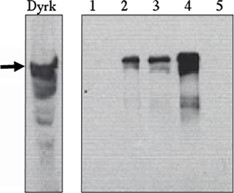Catalogue

Sheep anti Mouse Dyrk (Downs Syndrome critical region)
Catalog number: X1079P| Isotype | IgG |
| Product Type |
Polyclonal Antibody |
| Units | 100 µg |
| Host | Sheep |
| Species Reactivity |
Human Mouse Rat |
| Application |
Immunohistochemistry Immunoprecipitation Western Blotting |
Background
Dyrk, the vertebrate of Drosophilia minibrain, is a dual-specificity kinase predominately expressed in the central nervous system. The human clone has been isolated from the Downs' syndrome critical region and it is potentially implicated in the neuropathology of the disease. Main features of the protein include an N-terminal nuclear translocation signal, a putative leucine zipper domain, a core kinase domain with some similarity to kinases involved in cell cycle regulation and a C-terminal PEST sequence. The Dyrk kinase can be phosphorylated on tyrosine residues, leading to an active kinase that can phosphorylated itself or exogenous substrates on both tyrosine and serine/threonine residues. Dyrk can also multimerize and translocate to the nucleus. Present studies on Dyrk suggest a potential role for this kinase in the exit from the cell cycle and the beginning of neuronal differentiation.
Synonyms: Dual Specificity (Tyrosine and serine/threonine kinase) Kinase
Source
Sheep were immunized with a recombinant protein corresponding to amino acids 486 to 763 of the mouse Dyrk1A protein.
Product
Provided as solution in phosphate buffered saline with 0.08% sodium azide
Product Form: Unconjugated
Purification Method: Ammonium Sulfate Precipitation
Concentration: See vial for concentration
Applications
Detects Dyrk by immunofluorescence at 1 to 10 µg/ml. Detects Dyrk by Western blot at 1 µg/ml. Can also be used for immunoprecipitation. Optimal concentration should be evaluated by serial dilutions.
Functional Analysis: Western Blotting
Positive Control: Expressed in a variety of embryonic and adult tissues. Expressed abundantly in neurons of the brain, spinal cord, and retina in developing embryos.
Storage
Product should be stored at -20°C. Aliquot to avoid freeze/thaw cycles
Product Stability: See expiration date on vial
Shipping Conditions: Ship at ambient temperature, freeze upon arrival
Caution
This product is intended FOR RESEARCH USE ONLY, and FOR TESTS IN VITRO, not for use in diagnostic or therapeutic procedures involving humans or animals. It may contain hazardous ingredients. Please refer to the Safety Data Sheets (SDS) for additional information and proper handling procedures. Dispose product remainders according to local regulations.This datasheet is as accurate as reasonably achievable, but Nordic-MUbio accepts no liability for any inaccuracies or omissions in this information.
References
1. Kentrup, H., et al., Dyrk, a dual specificity protein kinase with unique structural features whose activity is dependent on tyrosine residues between subdomains VII and VIII. J. Biol. Chem. 1996, 271, 3488-3495.
2. Song, W.-J., et al., Isolation of human and murine homologues of the Drosophilia minibrain gene: Human homologue maps to 21q22.2 in the Down syndrome critical region. Genomics 1996, 38, 331-339.
3. Becker, W. & Joost, H.G. Structural and functional characteristics of Dyrk, a novel subfamily of protein kinases with dual specificity. Prog. Nucleic Acid Res. Mol. Biol. 1999, 62, 1-17.
Safety Datasheet(s) for this product:
| NM_Sodium Azide |

"Immunoprecipitation of Dyrk from 293T transfected cells. Immunoprecipitation with - 1) control Ab, 2) Anti-MNP 2 µg/ml, 3) Exalpha’s anti-Dyrk 2 µg/ml, 4) Exalpha’s anti-Dyrk 10 µg/ml, 5) competitor’s anti-Dyrk Ab 10 µg/ml, Western blot performed with Exalpha’s anti-Dyrk Ab at 2 µg/ml."

